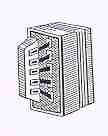 Note: Karl Weyde of Hamburg, who is experienced in archaic
German handwriting, rendered the original German into modern German. His
son, Martin, translated into English, and Henry Doktorski edited the
English. Martin wrote, "This is no translation, it's a summary. The patent
is written in archaic idioms and there is no guarantee on correctness. Any
specialist of the Austrian language of the early 19th century is welcome
to do a literal translation of the document."
Note: Karl Weyde of Hamburg, who is experienced in archaic
German handwriting, rendered the original German into modern German. His
son, Martin, translated into English, and Henry Doktorski edited the
English. Martin wrote, "This is no translation, it's a summary. The patent
is written in archaic idioms and there is no guarantee on correctness. Any
specialist of the Austrian language of the early 19th century is welcome
to do a literal translation of the document." German readers may go to http://www.accordion-online.de/instrum/demian.htm to view the modern German translation. Special thanks to Dr. Herbert Scheibenreif for providing photocopies of the original document. The illustration on the left of Demian's accordion is from the archive of Dr. Alfred Mirek of Moscow.